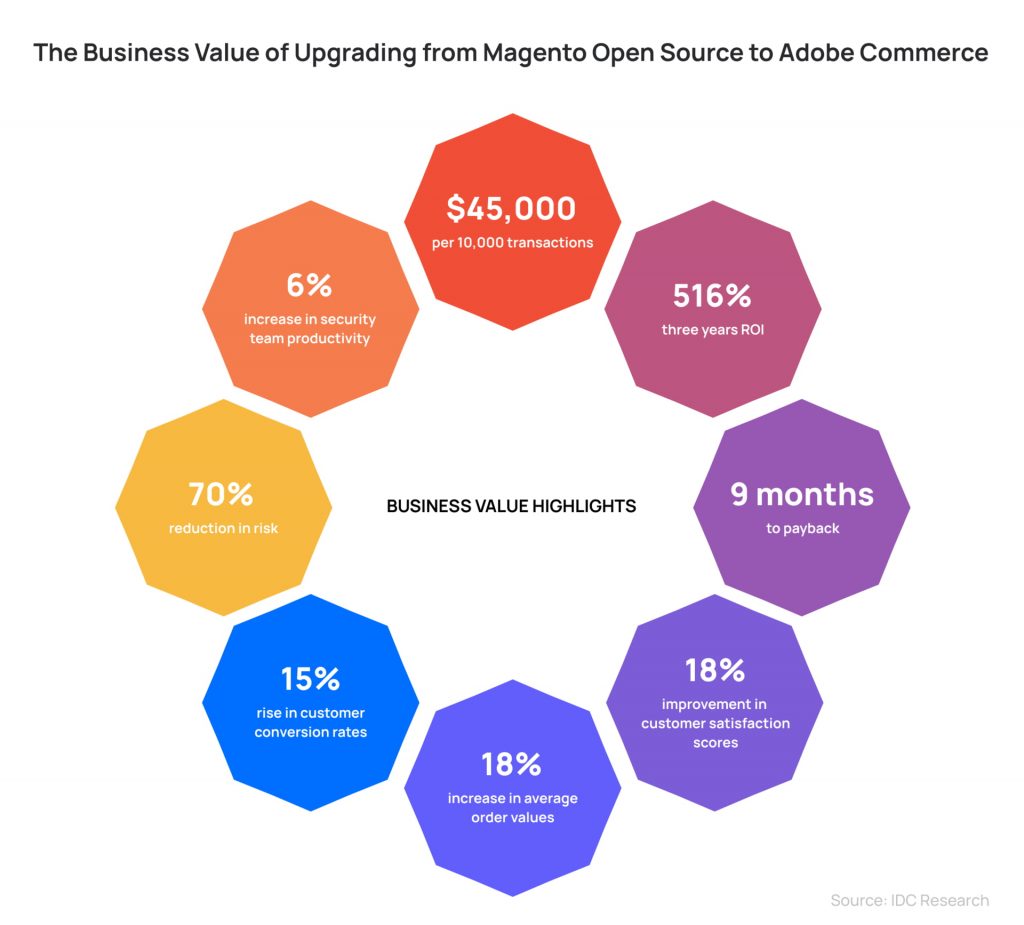Whether Commerce or the Open Source version is a better option for business owners has always been a hot topic. However, after April 2021, when Magento Commerce was integrated into Adobe Experience Cloud and became Adobe Commerce, Magento Open Source faced a time of uncertainty.
Some experts believe that Magento Open Source will soon become a part of history. Others say it is not only viable but experiencing a renaissance. The only thing everybody is sure is that Adobe Commerce is thriving.
Today, we’ll dive deeper into the never-ending Magento Open Source vs Adobe Commerce debate and try to figure out which one you should choose for your business. And if you need assistance choosing the right platform for your business, check out Adobe Commerce Consulting. Our experts are always ready to answer all your questions.
What is Magento Open Source?
Magento Open Source, previously known as Magento Community Edition, is a free open-source ecommerce platform. It was developed by Varien Inc. and first released in March 2008. Since then, it has evolved significantly in terms of functionality and features.
Magento functionality revolves around creating and managing online stores. It provides all the necessary features for managing products, orders, customers, and payments. The platform gained popularity due to its flexibility. Since its code remains open source, the platform is easy to customize.
Another factor that adds up to Magento’s popularity is its scalability. When optimized correctly, the platform can handle hundreds of thousands of products.
What is Adobe Commerce?
Adobe Commerce, formerly known as Magento Commerce, is a commercial version of Magento that offers additional enterprise-level features and support.
Technologically and functionally, Adobe Commerce shares the same foundation as Magento Open Source. At first glance, it seems that these platforms are almost identical.
However, according to IDC research, businesses that transitioned from Magento Open Source to Adobe Commerce experienced a notable boost in yearly benefits, averaging $45,000 per 10,000 transactions.
Additionally, they noticed enhancements in other key metrics, such as:
- customer satisfaction ratings
- average order values
- conversion rate
- return on investment (ROI).
The Business Value of Upgrading from Magento Open Source to Adobe Commerce

So, let’s dive deeper into the difference between Adobe Commerce and Magento Open Source and compare them side by side.
Magento Open Source vs. Adobe Commerce
When comparing Magento Open Source vs. Commerce, you will notice that Adobe’s proprietary version includes all the features of the open-source version and adds unique benefits related to B2B ecommerce, marketing, and the use of AI.
Features
The table below compares the main features to highlight the similarities and differences between these solutions. You can check the full feature list here.
| Features | Magento Open Source | Adobe Commerce |
| Catalog management | Both versions of the ecommerce platform come with a set of tools necessary for effective catalog management, including:Any product typeProduct AttributesAutomatic image resizing and watermarkingLayered NavigationCustom Order StatusesCustomer account managementCategory structure management | Adobe Commerce has all the open source features plus additional:Category PermissionsGift CardsGift WrapOrder Management System |
| Content management | Even though Magento is an ecommerce platform, it also has some content management features, such as: Page BuilderCMS PagesCMS BlocksCMS WidgetsMedia GalleryAdobe Stock Integration | Adobe Commerce extends the list of open-source features with:Content stagingPreviewSchedulingPage HierarchyDynamic Blocks |
| Website management | Website management is very similar in both versions and includes the following features: Multistore functionality Support for multiple languages and currenciesAPI integrationsTax ratesCAPTCHA | Adobe Commers comes with 2 additional features: Archive ordersReturn merchandise authorization (RMA) |
| Checkout, payment, and shipping | Both versions of the ecommerce platform come with all the necessary features for secure checkout, payment, and shipping:Customizable checkoutOne-page checkoutGuest checkoutDifferent payment methodsDiscount codesShipping to multiple addresses in one orderShipping integrations with major carriersTable rates | Checkout, payment, and shipping features are almost identical. The only noticeable difference is that Adobe Commerce offers Address Search. |
| Marketing, promotions, and conversion tools | Magento Open Source offers only the basic marketing features:Catalog promotional pricingWishlistCategory landing pagesReviewsNewsletter subscriptionGoogle Shopping APIGoogle SitemapSearch engine-friendly URLsURL rewritesRelated Product Rules | Adobe Commerce, in turn, offers an advanced list of marketing features such as:Customer segmentsCustomer AttributesVisual MerchandiserReward PointsPrivate Sales & Events Countdown tickerStore CreditWishlist SearchEmail Reminders |
| Analytics and reporting | Both Magento Open Source and Adobe Commerce come with built-in advanced reporting powered by Magento Business Intelligence. | However, Since Adobe Commerce offers more features initially, it also has more reports based on those additional features such as Private Sales, WishLists, and Segments. |
| B2B features | Magento Open Source doesn’t include any B2B functionality. | One of the main advantages of Adobe Commerce is that it has all the essential B2B features out of the box:Shared CatalogsCompany CreditCompany AccountsQuick Orders by SKU or Product NameQuotesPayment on AccountRequisition Lists |
| Adobe Sensei | Magento Open Source doesn’t provide access to AI-powered features. | Adobe Sensei is an AI tool that strengthens Adobe Commerce with the power of artificial intelligence and machine learning. Adobe Sensei offers three main features to improve user experience:Live SearchProduct recommendationsMerchandising |
| Adobe Target | Magento Open Source doesn’t integrate natively with Adobe Target. | Adobe Commerce easily connects to Adobe Target, for testing, automation, and personalization. It helps merchants and marketers customize content and experiences to boost revenue, conversions, and engagement across various customer touchpoints. |
| Site-Wide Analysis Tool (SWAT) | Magento Open Source doesn’t provide access to the SWAT tool. | SWAT examines website performance, creates reports, and offers suggestions for enhancing performance. |
Adobe Commerce Cloud vs. Magento
Adobe Commerce also offers a cloud-native solution. Adobe Commerce Cloud is a Platform-as-a-Service (PaaS) hosted on AWS-based cloud infrastructure. It provides streamlined server management and DevOps tools, eliminating the need for manual server configuration.

Key advantages of Adobe Commerce Cloud vs. Magento include:
- A fully configured environment eliminates concerns about server software compatibility, with additional tools like Elasticsearch available.
- Integrated GIT source control management system supports eight environments for development, testing, and deployment. This aids in seamless collaboration among teams, speeding up project delivery and improving time-to-market.
- Infrastructure-as-a-Service (IaaS). Three-server setup for Production and Staging environments ensures reliability and availability. As a result, the platform becomes more stable for business-critical applications, enhancing customer satisfaction and loyalty.
- Fastly for CDN and caching improves website performance through faster page load times, lower bounce rates, and improved search engine rankings. This, in turn, drives website traffic and elevates conversion rates.
- Blackfire Profiler and New Relic APM help monitor system performance and identify and address bottlenecks and inefficiencies.
- RabbitMQ message broker ensures real-time data exchange and supports the growth of the business without compromising performance.
- GitHub/Bitbucket integration provides a centralized repository for code, version tracking, and audit trails, improving code quality, consistency, and regulatory compliance.
Pricing and Licensing
Magento Open Source is available for free, while Adobe Commerce requires a licensing fee. This fee is calculated as a percentage of your business’ yearly revenue. The pricing structure for Adobe Commerce is based on metrics such as Gross Merchandise Value (GMV) and Average Order Value (AOV).
Growth Potential
For fast-growing businesses, Magento Open Source may pose scalability limitations as it supports only a single database system. This constraint can potentially impact performance when managing multiple websites and storefronts.
In contrast, Adobe Commerce is specifically designed to cater to mid-to-enterprise-level businesses with large catalogs, high transaction volumes, and multiple storefronts. It excels in managing peak traffic scenarios.
Adobe Commerce comes with all essential features to support growth. In contrast, Magento Open Source may require building additional components, potentially slowing down growth progress.
Security
Adobe Commerce offers stronger security measures compared to Magento Open Source. Notably, the free version lacks essential features such as credit card tokenization and PCI DSS compliance.
Adobe Commerce meets PCI requirements and incorporates the Magento Secure Payment Bridge to guarantee secure card processing.
Additionally, it offers bug bounty programs, and regular scanning, and supports secure payment gateways such as PayPal and Authorize.net. Action Logs track all the changes done in the admin panel, enhancing overall security.
Moreover, Adobe Commerce Cloud provides CDN and DDoS protection, along with Fastly Web Application Firewall, so that businesses can safeguard their online presence against cyber threats and uphold customer trust.
Time-To-Market
Lastly, an undeniable advantage of Adobe Commerce is its fast time-to-market. It offers pre-built functionality, speeding up setup. At the same time, it retains a high degree of flexibility, allowing for extensive customization to meet your unique needs.
Criteria for Choosing the Right Platform
Here are the main factors you should consider to ensure the chosen platform aligns with your business needs:
- Objectives and requirements of your business: Evaluate the specific goals and requirements of your business, such as the size of your catalog, target audience, and desired features. Determine whether Magento Open Source or Adobe Commerce better meets your needs in terms of functionality, scalability, and customization options.
- Financial aspect: Consider your budget and evaluate the initial investment required for both Magento Open Source and Adobe Commerce. Compare the cost of ownership, including licensing fees, development expenses, and maintenance costs, to determine the most cost-effective solution for your business.
- Compatibility with third-party systems: Examine the compatibility of Magento Open Source and Adobe Commerce with third-party systems such as ERP, CRM, payment gateways, and shipping providers that you are planning to use.
- Growth potential: Try to forecast how your business will grow in the next couple of years and consider which platform provides the necessary capabilities to support increased traffic, transactions, and product offerings.
- Migration from other platforms: If migrating from another platform, consider the ease of transition and the support available for data migration, customization, and integration. The migration process is never easy, but Axamit’s team is here and ready to assist you with Adobe Commerce implementation. Our developers will ensure a smooth transition and minimize disruption to your business operations.
Ongoing support and system maintenance: Evaluate the level of support and system maintenance offered by Magento Open Source and Adobe Commerce providers. Consider what kind of technical assistance, updates, and ongoing support services you may need to ensure the continued smooth operation of your ecommerce platform.
Conclusion
Choosing between Magento Open Source and Adobe Commerce can be challenging. Yet, the growing concerns about the unclear future of Magento Open Source do not speak in its favor. Meanwhile, Adobe Commerce continues to demonstrate the value of the advanced features, scalability, and security it brings to the table.
If you require the opinion of a technology expert to determine which platform is best suited for your business needs, budget, and growth trajectory, we are here to assist you. Our goal is to ensure that your company makes a seamless transition and establishes a solid foundation for long-term growth.



